Analyzing IoT in Healthcare: WBAN Impact, Security & Trust Factors
VerifiedAdded on 2023/04/20
|47
|11444
|193
Report
AI Summary
This report explores the impact of the Internet of Things (IoT) on the healthcare industry, specifically focusing on Wireless Body Area Networks (WBAN). It begins by introducing the background of IoT in healthcare and the problem statement related to trust in new technologies and security concerns. The research aims to analyze the impact of IoT in healthcare through WBAN, identify security and privacy threats, assess public trust levels, and recommend mitigation strategies. The literature review examines the concept of IoT in healthcare, the functionality of WBAN, and existing research on security breaches and cloud computing integration. The research methodology outlines the philosophical approach, design, data collection, and analysis methods used. The data findings and analysis chapter presents and interprets the collected data. Finally, the conclusion and recommendation chapter summarizes the findings, links them to the research objectives, and provides recommendations for improving the implementation of IoT in healthcare.

Running head: IOT IN HEALTHCARE WIRELESS BODY AREA NETWORK (WBAN)
IoT in healthcare Wireless Body Area Network (WBAN)
Name of the Student
Name of the University
IoT in healthcare Wireless Body Area Network (WBAN)
Name of the Student
Name of the University
Paraphrase This Document
Need a fresh take? Get an instant paraphrase of this document with our AI Paraphraser
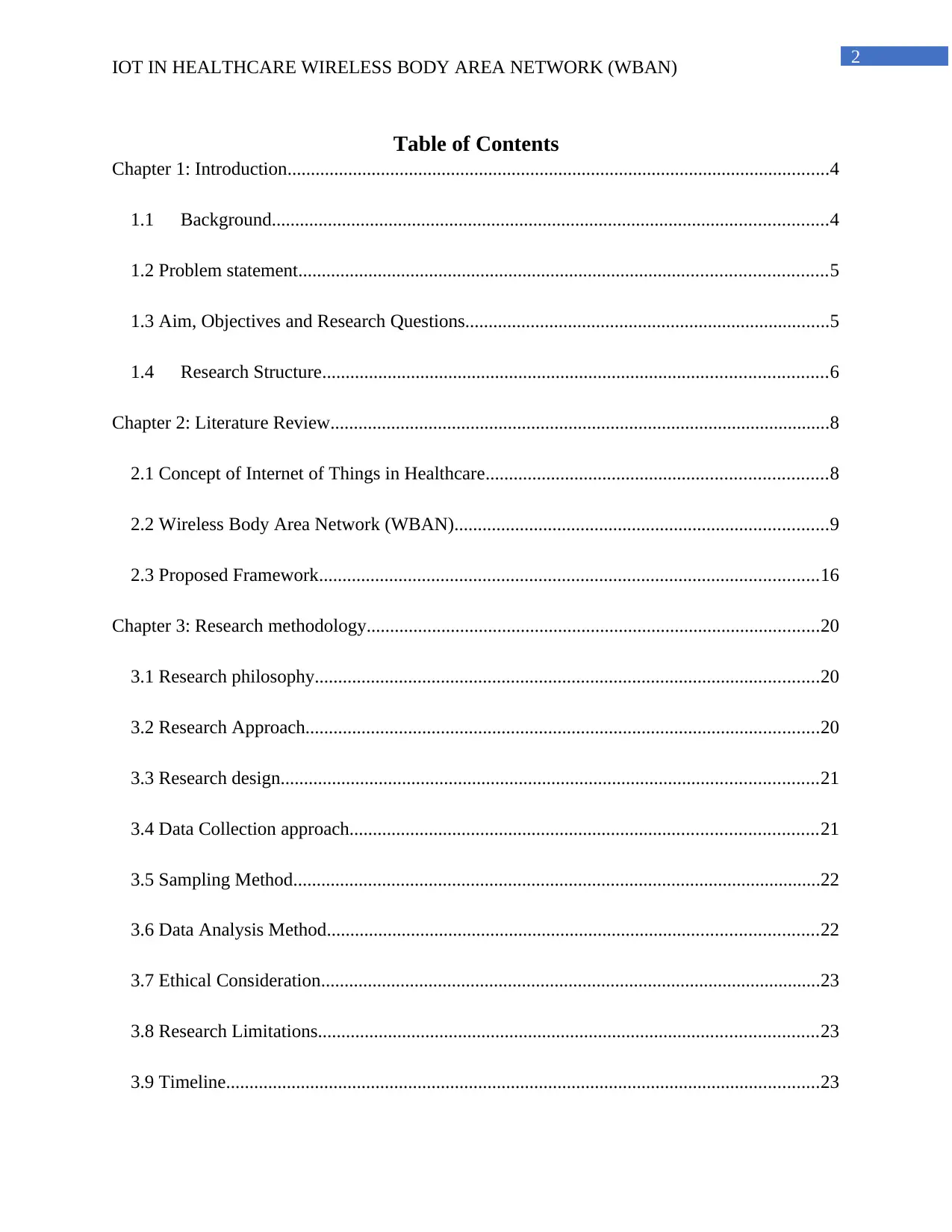
2
IOT IN HEALTHCARE WIRELESS BODY AREA NETWORK (WBAN)
Table of Contents
Chapter 1: Introduction....................................................................................................................4
1.1 Background.......................................................................................................................4
1.2 Problem statement.................................................................................................................5
1.3 Aim, Objectives and Research Questions..............................................................................5
1.4 Research Structure............................................................................................................6
Chapter 2: Literature Review...........................................................................................................8
2.1 Concept of Internet of Things in Healthcare.........................................................................8
2.2 Wireless Body Area Network (WBAN)................................................................................9
2.3 Proposed Framework...........................................................................................................16
Chapter 3: Research methodology.................................................................................................20
3.1 Research philosophy............................................................................................................20
3.2 Research Approach..............................................................................................................20
3.3 Research design...................................................................................................................21
3.4 Data Collection approach....................................................................................................21
3.5 Sampling Method.................................................................................................................22
3.6 Data Analysis Method.........................................................................................................22
3.7 Ethical Consideration...........................................................................................................23
3.8 Research Limitations...........................................................................................................23
3.9 Timeline...............................................................................................................................23
IOT IN HEALTHCARE WIRELESS BODY AREA NETWORK (WBAN)
Table of Contents
Chapter 1: Introduction....................................................................................................................4
1.1 Background.......................................................................................................................4
1.2 Problem statement.................................................................................................................5
1.3 Aim, Objectives and Research Questions..............................................................................5
1.4 Research Structure............................................................................................................6
Chapter 2: Literature Review...........................................................................................................8
2.1 Concept of Internet of Things in Healthcare.........................................................................8
2.2 Wireless Body Area Network (WBAN)................................................................................9
2.3 Proposed Framework...........................................................................................................16
Chapter 3: Research methodology.................................................................................................20
3.1 Research philosophy............................................................................................................20
3.2 Research Approach..............................................................................................................20
3.3 Research design...................................................................................................................21
3.4 Data Collection approach....................................................................................................21
3.5 Sampling Method.................................................................................................................22
3.6 Data Analysis Method.........................................................................................................22
3.7 Ethical Consideration...........................................................................................................23
3.8 Research Limitations...........................................................................................................23
3.9 Timeline...............................................................................................................................23
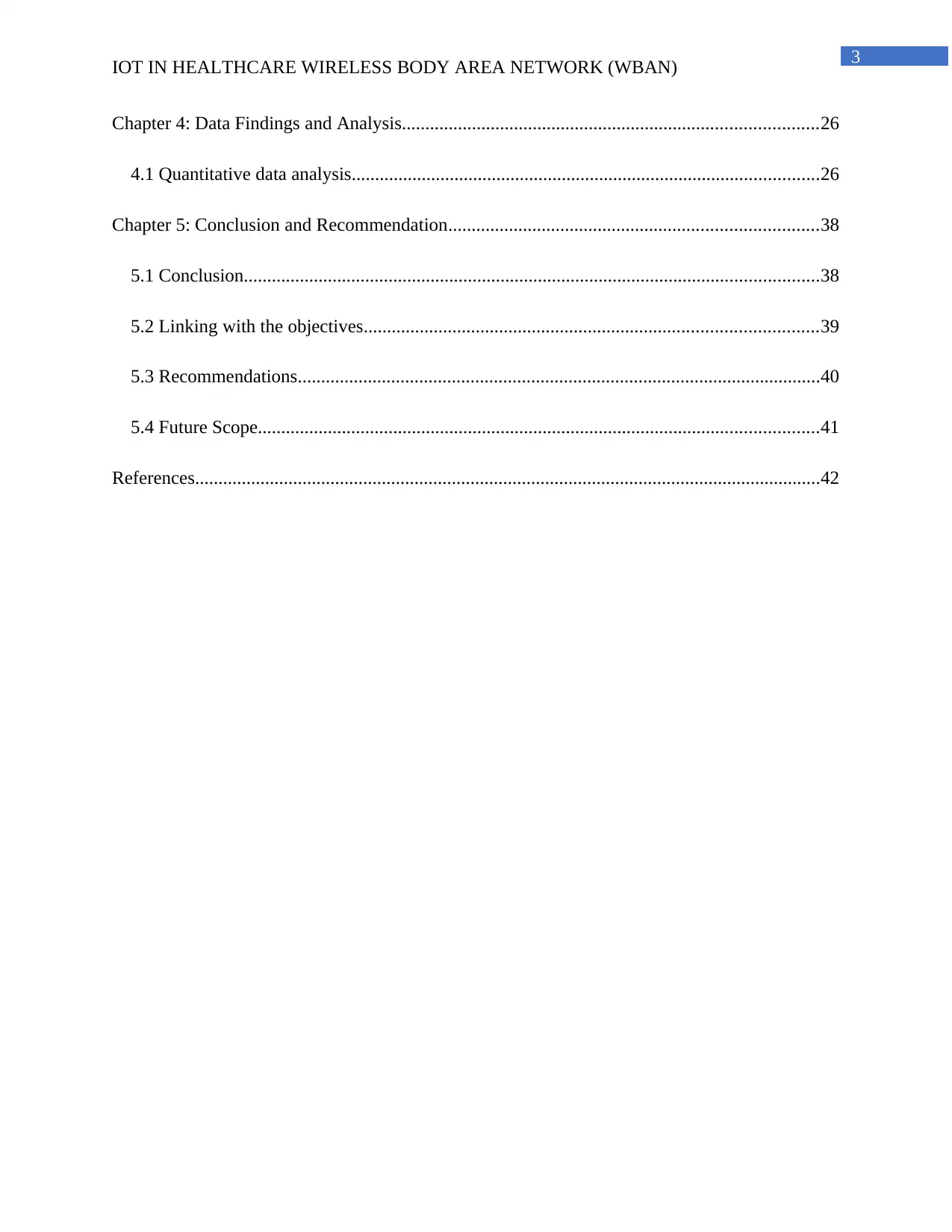
3
IOT IN HEALTHCARE WIRELESS BODY AREA NETWORK (WBAN)
Chapter 4: Data Findings and Analysis.........................................................................................26
4.1 Quantitative data analysis....................................................................................................26
Chapter 5: Conclusion and Recommendation...............................................................................38
5.1 Conclusion...........................................................................................................................38
5.2 Linking with the objectives.................................................................................................39
5.3 Recommendations................................................................................................................40
5.4 Future Scope........................................................................................................................41
References......................................................................................................................................42
IOT IN HEALTHCARE WIRELESS BODY AREA NETWORK (WBAN)
Chapter 4: Data Findings and Analysis.........................................................................................26
4.1 Quantitative data analysis....................................................................................................26
Chapter 5: Conclusion and Recommendation...............................................................................38
5.1 Conclusion...........................................................................................................................38
5.2 Linking with the objectives.................................................................................................39
5.3 Recommendations................................................................................................................40
5.4 Future Scope........................................................................................................................41
References......................................................................................................................................42
⊘ This is a preview!⊘
Do you want full access?
Subscribe today to unlock all pages.

Trusted by 1+ million students worldwide

4
IOT IN HEALTHCARE WIRELESS BODY AREA NETWORK (WBAN)
Chapter 1: Introduction
1.1 Background
The Internet of Things (IoT) has been used to design a body sensor network (BSN) in which
sensors can be monitored and handled with the help of Wi-Fi access beyond the location. There
has been the growth in smart devices in recent years. IoT has been capitalizing the technology
market in recent years (Wu et al. 2017). Various smart systems have been used in the healthcare
industry for providing quality healthcare services to people. These small interconnected devices
have been helping in various fields including healthcare sector. A Primary application in the
smart healthcare system in which doctors are able to monitor symptoms of patient remotely by
the use of Wireless Body Area Network in IoT environment. An IoT environment has been
depended on security and privacy which has been still questionable in many IoT architecture.
Sensors connected on a human body perceive phenomenon including heartbeat and Body Area
network. The main concern of these sensors has been ensuring a secure way for communicating
and coordinating among devices for forming a flawless system. Wireless Body Network
(WBAN) has been helping in communication between implanted sensors on human body
(Elhayatmy, Dey and Ashour 2018). Data used to be shared over internet, hence security
becomes an important concern for end users and connected devices. The security of data an
information of human body has been a major problem in the IoT. These sensor devices are used
to get diverse reactions of a patient like heartbeat, body temperature, heartbeat, breath and ECG,
etc and send these signs to a Body Network Controller (BNC). BNC is a fundamental piece of a
WBAN which is talented to get sensor data and in the wake of taking care of advances to the
united e-Health server. The e-Health server subsequently saves this steady data from various
patients that can be checked by his clinician.
IOT IN HEALTHCARE WIRELESS BODY AREA NETWORK (WBAN)
Chapter 1: Introduction
1.1 Background
The Internet of Things (IoT) has been used to design a body sensor network (BSN) in which
sensors can be monitored and handled with the help of Wi-Fi access beyond the location. There
has been the growth in smart devices in recent years. IoT has been capitalizing the technology
market in recent years (Wu et al. 2017). Various smart systems have been used in the healthcare
industry for providing quality healthcare services to people. These small interconnected devices
have been helping in various fields including healthcare sector. A Primary application in the
smart healthcare system in which doctors are able to monitor symptoms of patient remotely by
the use of Wireless Body Area Network in IoT environment. An IoT environment has been
depended on security and privacy which has been still questionable in many IoT architecture.
Sensors connected on a human body perceive phenomenon including heartbeat and Body Area
network. The main concern of these sensors has been ensuring a secure way for communicating
and coordinating among devices for forming a flawless system. Wireless Body Network
(WBAN) has been helping in communication between implanted sensors on human body
(Elhayatmy, Dey and Ashour 2018). Data used to be shared over internet, hence security
becomes an important concern for end users and connected devices. The security of data an
information of human body has been a major problem in the IoT. These sensor devices are used
to get diverse reactions of a patient like heartbeat, body temperature, heartbeat, breath and ECG,
etc and send these signs to a Body Network Controller (BNC). BNC is a fundamental piece of a
WBAN which is talented to get sensor data and in the wake of taking care of advances to the
united e-Health server. The e-Health server subsequently saves this steady data from various
patients that can be checked by his clinician.
Paraphrase This Document
Need a fresh take? Get an instant paraphrase of this document with our AI Paraphraser

5
IOT IN HEALTHCARE WIRELESS BODY AREA NETWORK (WBAN)
In recent scenario, individuals form different ages have been coming forward for
experiencing advancement of wearable devices that monitors blood pressure, blood glucose
levels, heartbeats and sleeping patterns. Medical smart devices are connected with the human
body that helps in collecting data from the human body related to health checkup. These sensors
have been providing an advanced way of clinical services for human body. However, with the
implementation of IoT in healthcare, security and privacy has been a major factor of threat for
smart devices (Liao et al. 2016). Data used to be shared over internet, hence security becomes an
important concern for end users and connected devices.
1.2 Problem statement
The major problem focused in this research has been the trust factor of human beings in
utilization of IoT in healthcare and smart devices for healthcare. Traditional method of
healthcare services have been continuing for long years and people have trust over those
traditional method of health care. However, with the advancement of technology, IoT has been
implemented in the health care industry. Thus, people are not able to trust in latest technologies
used in the modern healthcare services (Hasan et al. 2019). Wireless Body Area Networks
(WBAN) have been new technology that have been able to provide quality and instant healthcare
services to patients. Therefore, people need to show trust in these new technologies. However, on
other side, the use of technology has been creating opportunities for security and privacy threats
of data of human body to hackers. The security issue have been the major drawbacks of
implementing smart IoT devices in the healthcare industry.
1.3 Aim, Objectives and Research Questions
The aim of the research has been focused on impact of IoT on healthcare industry by the use
of Wireless Body Area Network (WBAN).
IOT IN HEALTHCARE WIRELESS BODY AREA NETWORK (WBAN)
In recent scenario, individuals form different ages have been coming forward for
experiencing advancement of wearable devices that monitors blood pressure, blood glucose
levels, heartbeats and sleeping patterns. Medical smart devices are connected with the human
body that helps in collecting data from the human body related to health checkup. These sensors
have been providing an advanced way of clinical services for human body. However, with the
implementation of IoT in healthcare, security and privacy has been a major factor of threat for
smart devices (Liao et al. 2016). Data used to be shared over internet, hence security becomes an
important concern for end users and connected devices.
1.2 Problem statement
The major problem focused in this research has been the trust factor of human beings in
utilization of IoT in healthcare and smart devices for healthcare. Traditional method of
healthcare services have been continuing for long years and people have trust over those
traditional method of health care. However, with the advancement of technology, IoT has been
implemented in the health care industry. Thus, people are not able to trust in latest technologies
used in the modern healthcare services (Hasan et al. 2019). Wireless Body Area Networks
(WBAN) have been new technology that have been able to provide quality and instant healthcare
services to patients. Therefore, people need to show trust in these new technologies. However, on
other side, the use of technology has been creating opportunities for security and privacy threats
of data of human body to hackers. The security issue have been the major drawbacks of
implementing smart IoT devices in the healthcare industry.
1.3 Aim, Objectives and Research Questions
The aim of the research has been focused on impact of IoT on healthcare industry by the use
of Wireless Body Area Network (WBAN).
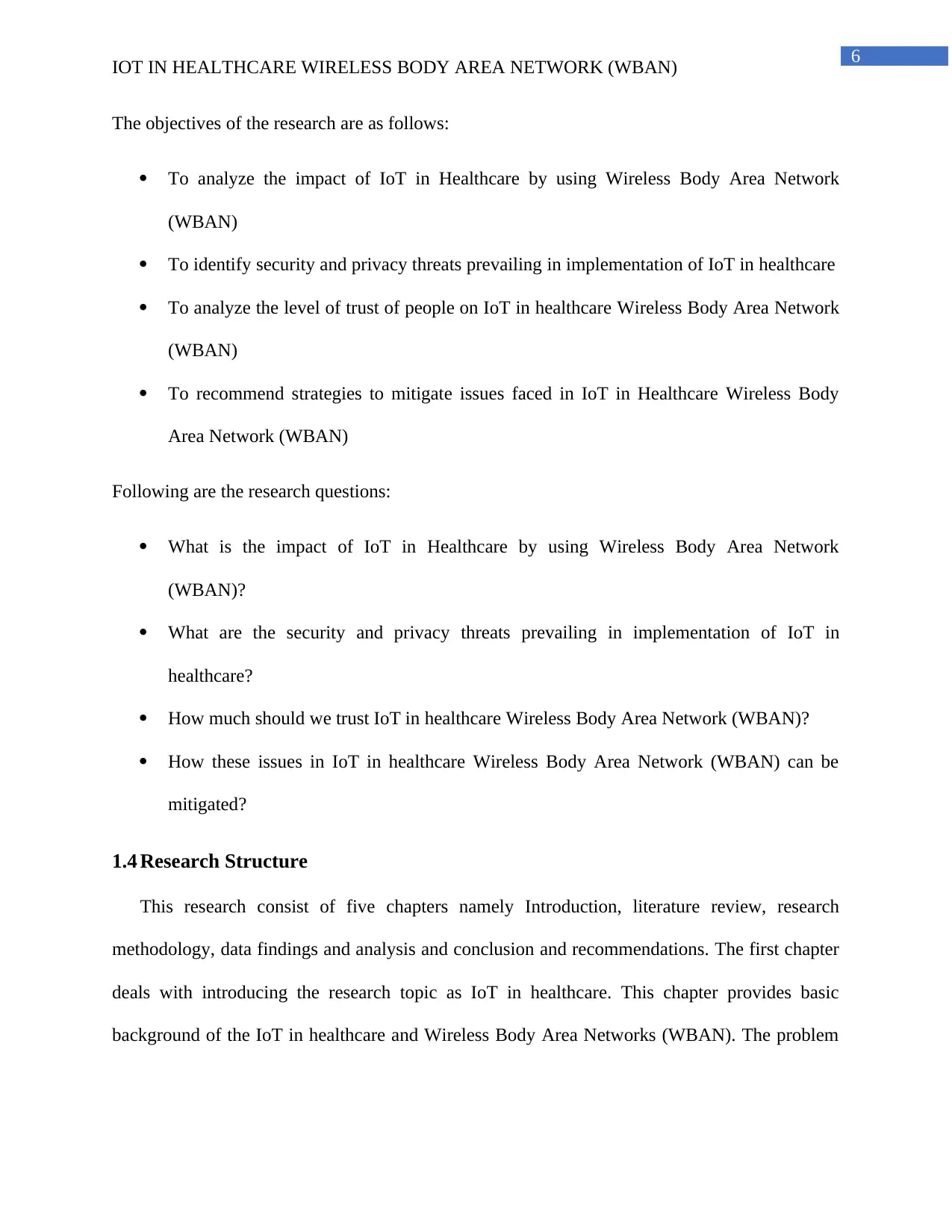
6
IOT IN HEALTHCARE WIRELESS BODY AREA NETWORK (WBAN)
The objectives of the research are as follows:
To analyze the impact of IoT in Healthcare by using Wireless Body Area Network
(WBAN)
To identify security and privacy threats prevailing in implementation of IoT in healthcare
To analyze the level of trust of people on IoT in healthcare Wireless Body Area Network
(WBAN)
To recommend strategies to mitigate issues faced in IoT in Healthcare Wireless Body
Area Network (WBAN)
Following are the research questions:
What is the impact of IoT in Healthcare by using Wireless Body Area Network
(WBAN)?
What are the security and privacy threats prevailing in implementation of IoT in
healthcare?
How much should we trust IoT in healthcare Wireless Body Area Network (WBAN)?
How these issues in IoT in healthcare Wireless Body Area Network (WBAN) can be
mitigated?
1.4 Research Structure
This research consist of five chapters namely Introduction, literature review, research
methodology, data findings and analysis and conclusion and recommendations. The first chapter
deals with introducing the research topic as IoT in healthcare. This chapter provides basic
background of the IoT in healthcare and Wireless Body Area Networks (WBAN). The problem
IOT IN HEALTHCARE WIRELESS BODY AREA NETWORK (WBAN)
The objectives of the research are as follows:
To analyze the impact of IoT in Healthcare by using Wireless Body Area Network
(WBAN)
To identify security and privacy threats prevailing in implementation of IoT in healthcare
To analyze the level of trust of people on IoT in healthcare Wireless Body Area Network
(WBAN)
To recommend strategies to mitigate issues faced in IoT in Healthcare Wireless Body
Area Network (WBAN)
Following are the research questions:
What is the impact of IoT in Healthcare by using Wireless Body Area Network
(WBAN)?
What are the security and privacy threats prevailing in implementation of IoT in
healthcare?
How much should we trust IoT in healthcare Wireless Body Area Network (WBAN)?
How these issues in IoT in healthcare Wireless Body Area Network (WBAN) can be
mitigated?
1.4 Research Structure
This research consist of five chapters namely Introduction, literature review, research
methodology, data findings and analysis and conclusion and recommendations. The first chapter
deals with introducing the research topic as IoT in healthcare. This chapter provides basic
background of the IoT in healthcare and Wireless Body Area Networks (WBAN). The problem
⊘ This is a preview!⊘
Do you want full access?
Subscribe today to unlock all pages.

Trusted by 1+ million students worldwide
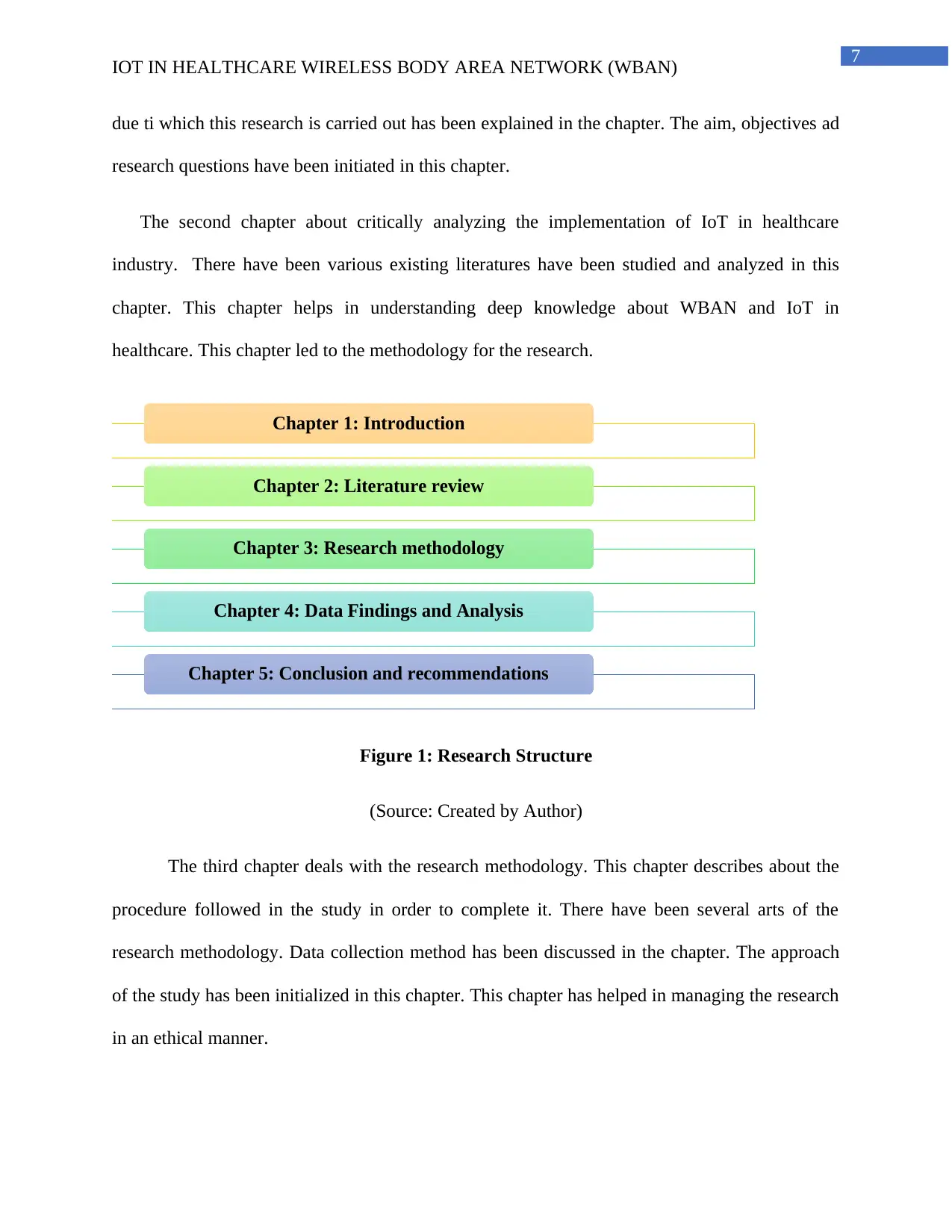
7
IOT IN HEALTHCARE WIRELESS BODY AREA NETWORK (WBAN)
due ti which this research is carried out has been explained in the chapter. The aim, objectives ad
research questions have been initiated in this chapter.
The second chapter about critically analyzing the implementation of IoT in healthcare
industry. There have been various existing literatures have been studied and analyzed in this
chapter. This chapter helps in understanding deep knowledge about WBAN and IoT in
healthcare. This chapter led to the methodology for the research.
Figure 1: Research Structure
(Source: Created by Author)
The third chapter deals with the research methodology. This chapter describes about the
procedure followed in the study in order to complete it. There have been several arts of the
research methodology. Data collection method has been discussed in the chapter. The approach
of the study has been initialized in this chapter. This chapter has helped in managing the research
in an ethical manner.
Chapter 1: Introduction
Chapter 2: Literature review
Chapter 3: Research methodology
Chapter 4: Data Findings and Analysis
Chapter 5: Conclusion and recommendations
IOT IN HEALTHCARE WIRELESS BODY AREA NETWORK (WBAN)
due ti which this research is carried out has been explained in the chapter. The aim, objectives ad
research questions have been initiated in this chapter.
The second chapter about critically analyzing the implementation of IoT in healthcare
industry. There have been various existing literatures have been studied and analyzed in this
chapter. This chapter helps in understanding deep knowledge about WBAN and IoT in
healthcare. This chapter led to the methodology for the research.
Figure 1: Research Structure
(Source: Created by Author)
The third chapter deals with the research methodology. This chapter describes about the
procedure followed in the study in order to complete it. There have been several arts of the
research methodology. Data collection method has been discussed in the chapter. The approach
of the study has been initialized in this chapter. This chapter has helped in managing the research
in an ethical manner.
Chapter 1: Introduction
Chapter 2: Literature review
Chapter 3: Research methodology
Chapter 4: Data Findings and Analysis
Chapter 5: Conclusion and recommendations
Paraphrase This Document
Need a fresh take? Get an instant paraphrase of this document with our AI Paraphraser
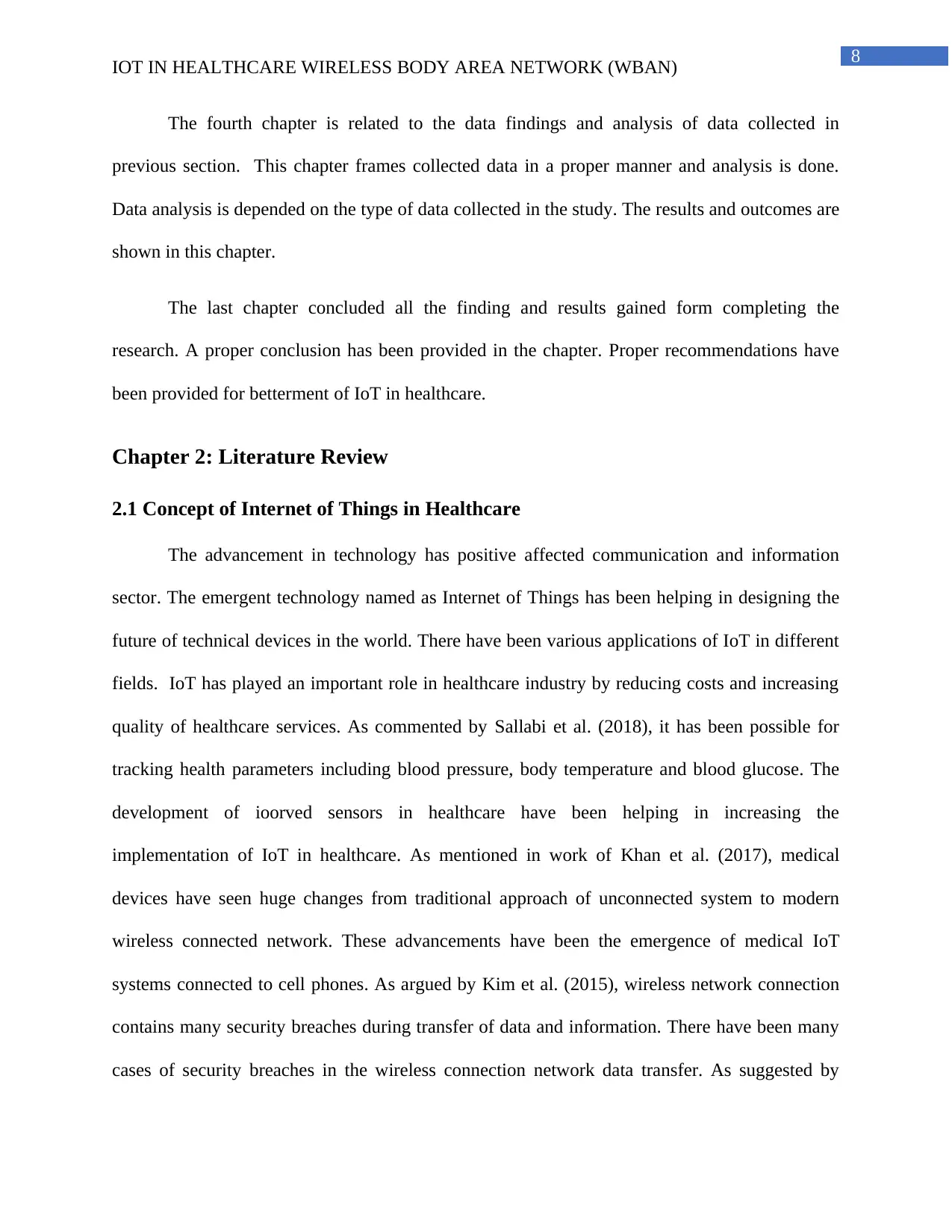
8
IOT IN HEALTHCARE WIRELESS BODY AREA NETWORK (WBAN)
The fourth chapter is related to the data findings and analysis of data collected in
previous section. This chapter frames collected data in a proper manner and analysis is done.
Data analysis is depended on the type of data collected in the study. The results and outcomes are
shown in this chapter.
The last chapter concluded all the finding and results gained form completing the
research. A proper conclusion has been provided in the chapter. Proper recommendations have
been provided for betterment of IoT in healthcare.
Chapter 2: Literature Review
2.1 Concept of Internet of Things in Healthcare
The advancement in technology has positive affected communication and information
sector. The emergent technology named as Internet of Things has been helping in designing the
future of technical devices in the world. There have been various applications of IoT in different
fields. IoT has played an important role in healthcare industry by reducing costs and increasing
quality of healthcare services. As commented by Sallabi et al. (2018), it has been possible for
tracking health parameters including blood pressure, body temperature and blood glucose. The
development of ioorved sensors in healthcare have been helping in increasing the
implementation of IoT in healthcare. As mentioned in work of Khan et al. (2017), medical
devices have seen huge changes from traditional approach of unconnected system to modern
wireless connected network. These advancements have been the emergence of medical IoT
systems connected to cell phones. As argued by Kim et al. (2015), wireless network connection
contains many security breaches during transfer of data and information. There have been many
cases of security breaches in the wireless connection network data transfer. As suggested by
IOT IN HEALTHCARE WIRELESS BODY AREA NETWORK (WBAN)
The fourth chapter is related to the data findings and analysis of data collected in
previous section. This chapter frames collected data in a proper manner and analysis is done.
Data analysis is depended on the type of data collected in the study. The results and outcomes are
shown in this chapter.
The last chapter concluded all the finding and results gained form completing the
research. A proper conclusion has been provided in the chapter. Proper recommendations have
been provided for betterment of IoT in healthcare.
Chapter 2: Literature Review
2.1 Concept of Internet of Things in Healthcare
The advancement in technology has positive affected communication and information
sector. The emergent technology named as Internet of Things has been helping in designing the
future of technical devices in the world. There have been various applications of IoT in different
fields. IoT has played an important role in healthcare industry by reducing costs and increasing
quality of healthcare services. As commented by Sallabi et al. (2018), it has been possible for
tracking health parameters including blood pressure, body temperature and blood glucose. The
development of ioorved sensors in healthcare have been helping in increasing the
implementation of IoT in healthcare. As mentioned in work of Khan et al. (2017), medical
devices have seen huge changes from traditional approach of unconnected system to modern
wireless connected network. These advancements have been the emergence of medical IoT
systems connected to cell phones. As argued by Kim et al. (2015), wireless network connection
contains many security breaches during transfer of data and information. There have been many
cases of security breaches in the wireless connection network data transfer. As suggested by
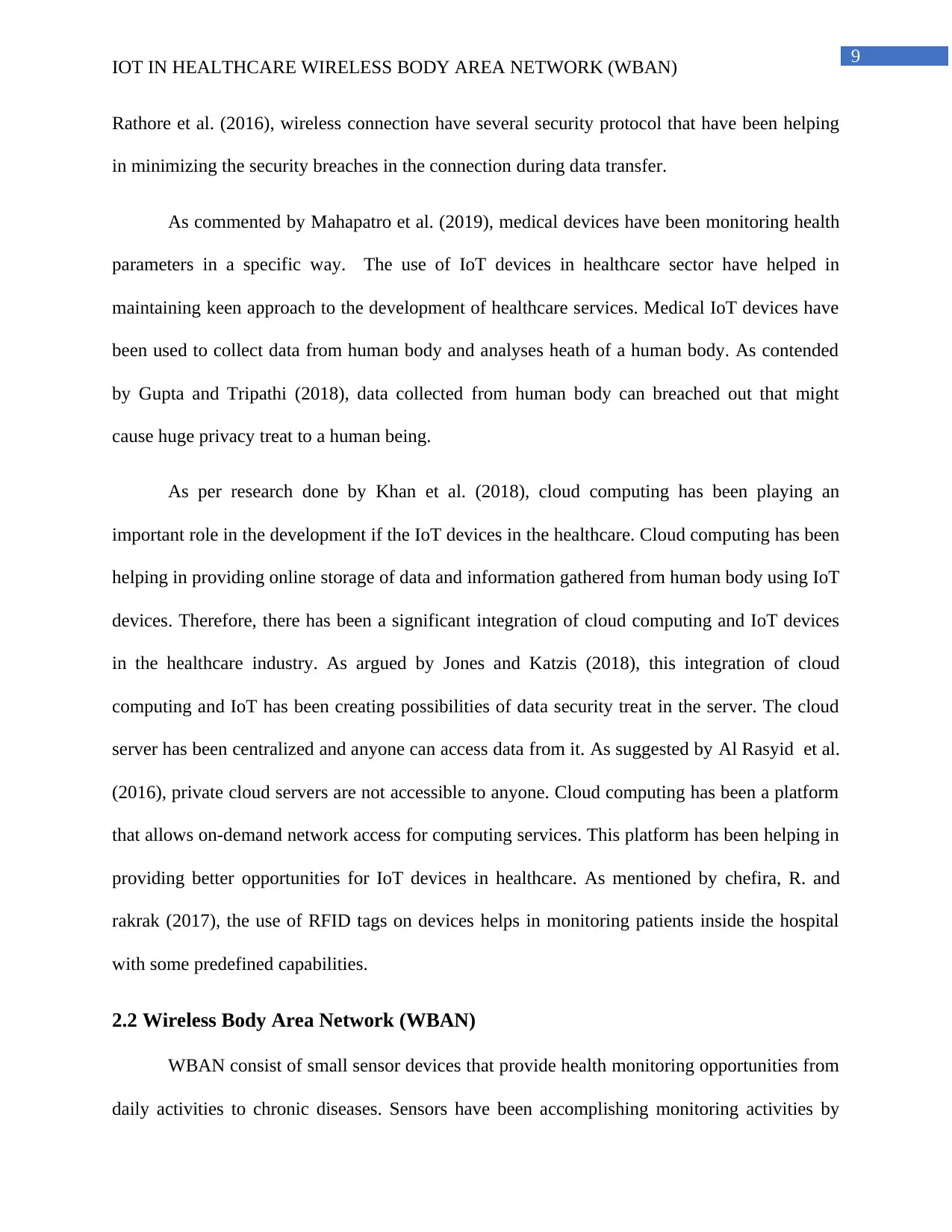
9
IOT IN HEALTHCARE WIRELESS BODY AREA NETWORK (WBAN)
Rathore et al. (2016), wireless connection have several security protocol that have been helping
in minimizing the security breaches in the connection during data transfer.
As commented by Mahapatro et al. (2019), medical devices have been monitoring health
parameters in a specific way. The use of IoT devices in healthcare sector have helped in
maintaining keen approach to the development of healthcare services. Medical IoT devices have
been used to collect data from human body and analyses heath of a human body. As contended
by Gupta and Tripathi (2018), data collected from human body can breached out that might
cause huge privacy treat to a human being.
As per research done by Khan et al. (2018), cloud computing has been playing an
important role in the development if the IoT devices in the healthcare. Cloud computing has been
helping in providing online storage of data and information gathered from human body using IoT
devices. Therefore, there has been a significant integration of cloud computing and IoT devices
in the healthcare industry. As argued by Jones and Katzis (2018), this integration of cloud
computing and IoT has been creating possibilities of data security treat in the server. The cloud
server has been centralized and anyone can access data from it. As suggested by Al Rasyid et al.
(2016), private cloud servers are not accessible to anyone. Cloud computing has been a platform
that allows on-demand network access for computing services. This platform has been helping in
providing better opportunities for IoT devices in healthcare. As mentioned by chefira, R. and
rakrak (2017), the use of RFID tags on devices helps in monitoring patients inside the hospital
with some predefined capabilities.
2.2 Wireless Body Area Network (WBAN)
WBAN consist of small sensor devices that provide health monitoring opportunities from
daily activities to chronic diseases. Sensors have been accomplishing monitoring activities by
IOT IN HEALTHCARE WIRELESS BODY AREA NETWORK (WBAN)
Rathore et al. (2016), wireless connection have several security protocol that have been helping
in minimizing the security breaches in the connection during data transfer.
As commented by Mahapatro et al. (2019), medical devices have been monitoring health
parameters in a specific way. The use of IoT devices in healthcare sector have helped in
maintaining keen approach to the development of healthcare services. Medical IoT devices have
been used to collect data from human body and analyses heath of a human body. As contended
by Gupta and Tripathi (2018), data collected from human body can breached out that might
cause huge privacy treat to a human being.
As per research done by Khan et al. (2018), cloud computing has been playing an
important role in the development if the IoT devices in the healthcare. Cloud computing has been
helping in providing online storage of data and information gathered from human body using IoT
devices. Therefore, there has been a significant integration of cloud computing and IoT devices
in the healthcare industry. As argued by Jones and Katzis (2018), this integration of cloud
computing and IoT has been creating possibilities of data security treat in the server. The cloud
server has been centralized and anyone can access data from it. As suggested by Al Rasyid et al.
(2016), private cloud servers are not accessible to anyone. Cloud computing has been a platform
that allows on-demand network access for computing services. This platform has been helping in
providing better opportunities for IoT devices in healthcare. As mentioned by chefira, R. and
rakrak (2017), the use of RFID tags on devices helps in monitoring patients inside the hospital
with some predefined capabilities.
2.2 Wireless Body Area Network (WBAN)
WBAN consist of small sensor devices that provide health monitoring opportunities from
daily activities to chronic diseases. Sensors have been accomplishing monitoring activities by
⊘ This is a preview!⊘
Do you want full access?
Subscribe today to unlock all pages.

Trusted by 1+ million students worldwide

10
IOT IN HEALTHCARE WIRELESS BODY AREA NETWORK (WBAN)
gathering and managing user data and communicates it to base station for sending data to the
respective health monitoring system. In general terms, there have been three types of
communication in WBAN including On-body, In-body and Off-body communication (Bhatt,
Dey and Ashour 2017). The deployment needs of WBAN has been depending on the domain for
monitoring healthcare and secure device from malicious intervention activities. Compromised
WBAN might led to serious risks including irrevocable condition and even death of patient. A
WBAN has been secure in case it provide privacy, confidentiality, integrity and authentication.
As commented by Hassan et al. (2017) providing a high level security has been main challenge
to the system engineers due to limited source of power and infrastructure of the WBAN system.
As argued by Ahmed et al. (2018), authentication has been crucial aspect for any kind of network
for communicating device. Therefore, WBAN has been lacking in has arena of authenticating
proper users to entire into the network. As research done by Dey et al. (2018), some aspects of
WBAN research include physical ad data link layer and comparing a number of low-power radio
technologies (Chatterjee et al. 2017). The remote body region systems (WBANs), are one of the
low power sensor organize, which gives effective and dependable framework to medicinal
services framework including embedded, non-embedded and wearable sensor gadgets for human
body. These sensor gadgets are utilized to catch different side effects of a patient like heartbeat,
body temperature, pulse, breath and ECG and so forth and send these manifestations to a Body
Network Controller (BNC). BNC is a basic bit of a WBAN which is skilled to catch sensor
information and in the wake of handling advances to the brought together e-Health server.
IOT IN HEALTHCARE WIRELESS BODY AREA NETWORK (WBAN)
gathering and managing user data and communicates it to base station for sending data to the
respective health monitoring system. In general terms, there have been three types of
communication in WBAN including On-body, In-body and Off-body communication (Bhatt,
Dey and Ashour 2017). The deployment needs of WBAN has been depending on the domain for
monitoring healthcare and secure device from malicious intervention activities. Compromised
WBAN might led to serious risks including irrevocable condition and even death of patient. A
WBAN has been secure in case it provide privacy, confidentiality, integrity and authentication.
As commented by Hassan et al. (2017) providing a high level security has been main challenge
to the system engineers due to limited source of power and infrastructure of the WBAN system.
As argued by Ahmed et al. (2018), authentication has been crucial aspect for any kind of network
for communicating device. Therefore, WBAN has been lacking in has arena of authenticating
proper users to entire into the network. As research done by Dey et al. (2018), some aspects of
WBAN research include physical ad data link layer and comparing a number of low-power radio
technologies (Chatterjee et al. 2017). The remote body region systems (WBANs), are one of the
low power sensor organize, which gives effective and dependable framework to medicinal
services framework including embedded, non-embedded and wearable sensor gadgets for human
body. These sensor gadgets are utilized to catch different side effects of a patient like heartbeat,
body temperature, pulse, breath and ECG and so forth and send these manifestations to a Body
Network Controller (BNC). BNC is a basic bit of a WBAN which is skilled to catch sensor
information and in the wake of handling advances to the brought together e-Health server.
Paraphrase This Document
Need a fresh take? Get an instant paraphrase of this document with our AI Paraphraser

11
IOT IN HEALTHCARE WIRELESS BODY AREA NETWORK (WBAN)
Figure 2: A typical WBAN in a smart healthcare system within the IoT network with its:
things, network, and applications
(Source: Dumka and Sah 2019)
As appeared in Figure 2, a BNC gathers and procedures information from the gadgets and
forward it to a server utilizing a remote access organize. The Wireless access organize which is
utilized in this situation is IEEE 802.11ah (Karchowdhury and Sen 2019). This standard is
particularly intended for IoT gadgets. There can be utilization of WLAN 802.11a/b/n
benchmarks yet IEEE 802.11ah has some extra element (Chefira, R. and Rakrak 2017).
IOT IN HEALTHCARE WIRELESS BODY AREA NETWORK (WBAN)
Figure 2: A typical WBAN in a smart healthcare system within the IoT network with its:
things, network, and applications
(Source: Dumka and Sah 2019)
As appeared in Figure 2, a BNC gathers and procedures information from the gadgets and
forward it to a server utilizing a remote access organize. The Wireless access organize which is
utilized in this situation is IEEE 802.11ah (Karchowdhury and Sen 2019). This standard is
particularly intended for IoT gadgets. There can be utilization of WLAN 802.11a/b/n
benchmarks yet IEEE 802.11ah has some extra element (Chefira, R. and Rakrak 2017).

12
IOT IN HEALTHCARE WIRELESS BODY AREA NETWORK (WBAN)
Figure 3: Comparison of variants of IEEE 802.11 WiFi standard
(Source: Gia et al. 2015)
The comparison of different IEEE 802.11 guidelines has been displayed in Figure 3. In
medical clinic region, various 802.11ah WLAN passages are designed and introduced. The e-
Health server is associated by means of IEEE 802.3 Ethernet with these passages. As clarified
previously, an e-Health server that stores continuous information is associated with web that
empowers specialists to get to this data from remote-end. In like manner, regular system here a
powerlessness ascends since the association among BNCs and e-Health server may have insider
threats and also, it might look outside assaults (Gia et al. 2015). Accordingly, it is basic to
actualize a system that guarantee the security for a brilliant Hospital.
Some cheap innovation that is additionally valuable for a short separation is the
Bluetooth. It is broadly utilized, in different gadgets, for example, mouse, console, and headset
and most prominent for individual gadgets correspondence, for the two information and voice.
IOT IN HEALTHCARE WIRELESS BODY AREA NETWORK (WBAN)
Figure 3: Comparison of variants of IEEE 802.11 WiFi standard
(Source: Gia et al. 2015)
The comparison of different IEEE 802.11 guidelines has been displayed in Figure 3. In
medical clinic region, various 802.11ah WLAN passages are designed and introduced. The e-
Health server is associated by means of IEEE 802.3 Ethernet with these passages. As clarified
previously, an e-Health server that stores continuous information is associated with web that
empowers specialists to get to this data from remote-end. In like manner, regular system here a
powerlessness ascends since the association among BNCs and e-Health server may have insider
threats and also, it might look outside assaults (Gia et al. 2015). Accordingly, it is basic to
actualize a system that guarantee the security for a brilliant Hospital.
Some cheap innovation that is additionally valuable for a short separation is the
Bluetooth. It is broadly utilized, in different gadgets, for example, mouse, console, and headset
and most prominent for individual gadgets correspondence, for the two information and voice.
⊘ This is a preview!⊘
Do you want full access?
Subscribe today to unlock all pages.

Trusted by 1+ million students worldwide
1 out of 47
Related Documents
Your All-in-One AI-Powered Toolkit for Academic Success.
+13062052269
info@desklib.com
Available 24*7 on WhatsApp / Email
![[object Object]](/_next/static/media/star-bottom.7253800d.svg)
Unlock your academic potential
Copyright © 2020–2025 A2Z Services. All Rights Reserved. Developed and managed by ZUCOL.


